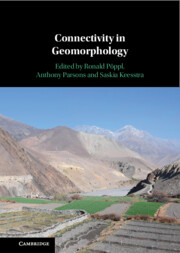Book contents
- Connectivity in Geomorphology
- Connectivity in Geomorphology
- Copyright page
- Contents
- Contributors
- Preface
- Acknowledgements
- Part I Introduction
- Part II Connectivity in Process Domains
- 3 Hillslope Processes
- 4 Fluvial Processes
- 5 Aeolian Processes
- 6 Glacial Processes
- 7 Periglacial Processes
- 8 Coastal and Deltaic Environments
- Part III Quantifying Connectivity in Geomorphology
- Part IV Managing Connectivity
- Index
- References
3 - Hillslope Processes
from Part II - Connectivity in Process Domains
Published online by Cambridge University Press: 10 April 2025
- Connectivity in Geomorphology
- Connectivity in Geomorphology
- Copyright page
- Contents
- Contributors
- Preface
- Acknowledgements
- Part I Introduction
- Part II Connectivity in Process Domains
- 3 Hillslope Processes
- 4 Fluvial Processes
- 5 Aeolian Processes
- 6 Glacial Processes
- 7 Periglacial Processes
- 8 Coastal and Deltaic Environments
- Part III Quantifying Connectivity in Geomorphology
- Part IV Managing Connectivity
- Index
- References
Summary
Hillslopes may be regarded as conveyor belts transferring water and sediment and nutrients to other parts of the geomorphic system. This chapter examines the mechanisms of, and the factors controlling, how far and how fast water, sediment and nutrients move along this conveyor belt, discussing water movement in and on hillslopes, fluid-gravity and sediment-gravity movement of sediment and nutrient movement. Hillslope processes do not operate in isolation, and the interaction, of connectivity among processes is also important. This interaction is particularly significant when assessing the importance of connectivity to understanding hillslopes within the context of landscape evolution. A full description of the connectivity of hillslope processes will require combined knowledge of both the magnitude–connectivity relationship, the probability distribution of event magnitudes and, to explain specific cases of functional connectivity, the actual sequence of events. In recent years there has been a growing recognition of the importance of connectivity in understanding the effects of hillslope processes. At best, however, that understanding remains patchy and incomplete.
- Type
- Chapter
- Information
- Connectivity in Geomorphology , pp. 29 - 47Publisher: Cambridge University PressPrint publication year: 2025

